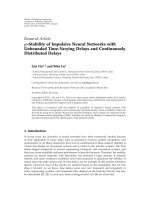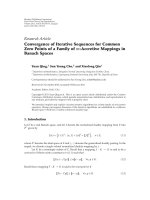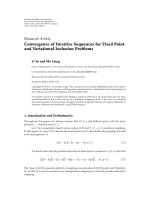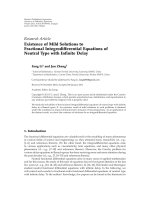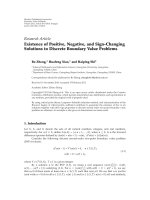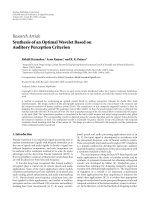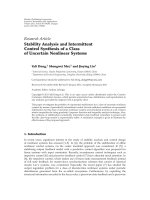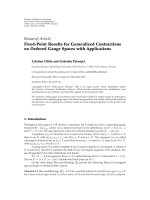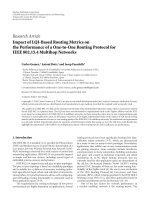Báo cáo hóa học: " Research Article Stability of Homomorphisms and Generalized Derivations on Banach Algebras" potx
Bạn đang xem bản rút gọn của tài liệu. Xem và tải ngay bản đầy đủ của tài liệu tại đây (506.28 KB, 12 trang )
Hindawi Publishing Corporation
Journal of Inequalities and Applications
Volume 2009, Article ID 595439, 12 pages
doi:10.1155/2009/595439
Research Article
Stability of Homomorphisms and Generalized
Derivations on Banach Algebras
Abbas Najati
1
and Choonkil Park
2
1
Department of Mathematics, Faculty of Sciences, University of Mohaghegh Ardabili,
Ardabil 56199-11367, Iran
2
Department of Mathematics, Hanyang University, Seoul 133-791, South Korea
Correspondence should be addressed to Choonkil Park,
Received 14 June 2009; Accepted 18 November 2009
Recommended by Sin-Ei Takahasi
We prove the generalized Hyers-Ulam stability of homomorphisms and generalized derivations
associated to the following functional equation f2x yfx 2yf3xf3y on Banach
algebras.
Copyright q 2009 A. Najati and C. Park. This is an open access article distributed under the
Creative Commons Attribution License, which permits unrestricted use, distribution, and
reproduction in any medium, provided the original work is properly cited.
1. Introduction
The first stability problem concerning group homomorphisms was raised from a question of
Ulam 1. Let G
1
, ∗ be a group and let G
2
, ,d be a metric group with the metric d·, ·.Given
ε>0, does there exist δ > 0 such that if a mapping h : G
1
→ G
2
satisfies the inequality
d
h
x ∗ y
,h
x
h
y
<δ 1.1
for all x, y ∈ G
1
, then there is a homomorphism H : G
1
→ G
2
with
d
h
x
,H
x
< 1.2
for all x ∈ G
1
?
Hyers 2 gave a first affirmative answer to the question of Ulam for Banach spaces.
Aoki 3 and Rassias 4 provided a generalization of the Hyers’ theorem for additive and
linear mappings, respectively, by allowing the Cauchy difference to be unbounded see also
5.
2 Journal of Inequalities and Applications
Theorem 1.1 Rassias. Let f : E → E
be a mapping from a normed vector space E into a Banach
space E
subject to the inequality
f
x y
− f
x
− f
y
≤ ε
x
p
y
p
1.3
for all x, y ∈ E,whereε and p are constants with ε>0 and p<1. Then the limit
L
x
lim
n →∞
f
2
n
x
2
n
1.4
exists for all x ∈ E and L : E → E
is the unique additive mapping which satisfies
f
x
− L
x
≤
2ε
2 − 2
p
x
p
1.5
for all x ∈ E.Ifp<0 then inequality 1.3 holds for x, y
/
0 and 1.5 for x
/
0. Also, if for each x ∈ E
the mapping t → ftx is continuous in t ∈ R,thenL is linear.
In 1994, a generalization of the Rassias’ theorem was obtained by G˘avrut¸a 6, who
replaced the bound εx
p
y
p
by a general control function ϕx, y. For the stability
problems of various functional equations and mappings and their Pexiderized versions, we
refer the readers to 7–15. We also refer readers to the books in 16–19.
Let A be a real or complex algebra. A mapping D : A → A is said to be a (ring)
derivation if
D
a b
D
a
D
b
,D
ab
D
a
b aD
b
1.6
for all a, b ∈ A. If, in addition, DλaλDa for all a ∈ A and all λ ∈ F, then D is called a
linear derivation, where F denotes the scalar field of A. Singer and Wermer 20
proved that if
A is a commutative Banach algebra and D : A → A is a continuous linear derivation, then
DA ⊆ radA. They also conjectured that the same result holds even D is a discontinuous
linear derivation. Thomas 21 proved the conjecture. As a direct consequence, we see that
there are no nonzero linear derivations on a semisimple commutative Banach algebra, which
had been proved by Johnson 22. On the other hand, it is not the case for ring derivations.
Hatori and Wada 23 determined a representation of ring derivations on a semi-simple
commutative Banach algebra see also 24 and they proved that only the zero operator
is a ring derivation on a semi-simple commutative Banach algebra with the maximal ideal
space without isolated points. The stability of derivations between operator algebras was
first obtained by
˘
Semrl 25. Badora 26 and Miura et al. 8 proved the Hyers-Ulam-Rassias
stability of ring derivations on Banach algebras. An additive mapping D : A → A is called a
Jordan derivation in case Da
2
Daa aDa is fulfilled for all a ∈ A. Every derivation
is a Jordan derivation. The converse is in general not true see 27, 28. The concept of
generalized derivation has been introduced by M. Bre
ˇ
sar 29. Hvala 30 and Lee 31
introduced a concept of θ, φ-derivation see also 32.Letθ, φ be automorphisms of A. An
additive mapping F : A → A is called a θ, φ-derivation in case FabFaθbφaFb
holds for all pairs a, b ∈ A. An additive mapping F : A → A is called a θ, φ-Jordan derivation
in case Fa
2
FaθaφaFa holds for all a ∈ A. An additive mapping F : A → A
Journal of Inequalities and Applications 3
is called a generalized θ, φ-derivation in case FabFaθbφaDb holds for all pairs
a, b ∈ A, where D : A → A is a θ, φ-derivation. An additive mapping F : A → A is
called a generalized θ, φ-Jordan derivation in case Fa
2
FaθaφaDa holds for all
a ∈ A, where D : A → A is a θ, φ-Jordan derivation. It is clear that every generalized
θ, φ-derivation is a generalized θ, φ-Jordan derivation.
The aim of the present paper is to establish the stability problem of homomorphisms
and generalized θ, φ-derivations by using the fixed point method see 7, 33–35.
Let E be a set. A function d : E × E → 0, ∞ is called a generalized metric on E if d
satisfies
i dx, y0 if and only if x y;
ii dx, ydy, x for all
x, y ∈ E;
iii dx, z ≤ dx, ydy, z for all x, y, z ∈ E.
We recall the following theorem by Margolis and Diaz.
Theorem 1.2 See 36. Let E, d be a complete generalized metric space and let J : E → E be a
strictly contractive mapping with Lipschitz constant L<1. Then for each given element x ∈ E,either
d
J
n
x, J
n1
x
∞ 1.7
for all nonnegative integers n or there exists a nonnegative integer n
0
such that
1 dJ
n
x, J
n1
x < ∞ for all n ≥ n
0
;
2 the sequence {J
n
x} converges to a fixed point y
∗
of J;
3 y
∗
is the unique fixed point of J in the set Y {y ∈ E : dJ
n
0
x, y < ∞};
4 dy,y
∗
≤ 1/1 − Ldy, Jy for all y ∈ Y .
2. Stability of Homomorphisms
Dar
´
oczy et al. 37 have studied the functional equation
f
px
1 − p
y
f
1 − p
x py
f
x
f
y
, 2.1
where 0 <p<1 is a fixed parameter and f : I → R is unknown, I is a nonvoid open interval
and 2.1 holds for all x, y ∈ I. They characterized the equivalence of 2.1 and Jensen’s
functional equation in terms of the algebraic properties of the parameter p. For p 1/2in
2.1, we get the Jensen’s functional equation. In the present paper, we establish the general
solution and some stability results concerning the functional equation 2.1 in normed spaces
for p 1/3. This applied to investigate and prove the generalized Hyers-Ulam stability of
homomorphisms and generalized derivations in real Banach algebras. In this section, we
assume that X is a normed algebra and Y is a Banach algebra. For convenience, we use the
following abbreviation for a given mapping f :
X→Y,
Df
x, y
: f
2x y
f
x 2y
− f
3x
− f
3y
2.2
for all x, y ∈X.
4 Journal of Inequalities and Applications
Lemma 2.1. Let X and Y be linear spaces. A mapping f : X → Y with f00 satisfies
f
2x y
f
x 2y
f
3x
f
3y
2.3
for all x, y ∈ X, if and only if f is additive.
Proof. Let f satisfy 2.3. Letting y 0in2.3,weget
f
x
f
2x
f
3x
2.4
for all x ∈ X. Hence
f
x
f
−x
f
2x
f
−2x
f
3x
f
−3x
2.5
for all x ∈ X. Letting y −x in 2.3,wegetfxf−xf3xf−3x for all x ∈ X.
Therefore by 2.5 we have f2xf−2x0 for all x ∈ X. This means that f is odd. Letting
y −
2x in 2.3 and using the oddness of f, we infer that f2x2fx for all x ∈ X. Hence
by 2.4 we have f3x3fx for all x ∈ X. Therefore it follows from 2.3 that f satisfies
f
2x y
f
x 2y
3
f
x
f
y
2.6
for all x, y ∈ X. Replacing x and y by 2y − x/3and2x −
y/3in2.6, respectively, we get
f
x
f
y
f
2x − y
f
2y − x
2.7
for all x, y ∈ X. Replacing y by −y in 2.7 and using the oddness of f,weget
f
2x y
− f
x 2y
f
x
− f
y
2.8
for all x,y ∈ X. Adding 2.6 to 2.8,wegetf2x y2
fxfy for all x, y ∈ X.
Using the identity f2x2fx and replacing x by x/2 in the last identity, we infer that
fx yfxfy for all x, y ∈ X. Hence f is additive. The converse is obvious.
Theorem 2.2. Let f : X→Ybe a mapping with f00 for which there exist functions ϕ, ψ :
X
2
→ 0, ∞ such that
lim
k →∞
1
2
k
ψ
2
k
x, y
lim
k →∞
1
2
k
ψ
x, 2
k
y
lim
k →∞
1
4
k
ψ
2
k
x, 2
k
y
0,
2.9
Df
x, y
≤ ϕ
x, y
, 2.10
f
xy
− f
x
f
y
≤ ψ
x, y
2.11
for all x, y ∈X. If there exists a constant 0 <L<1 such that
ϕ
2x, 2y
≤ 2Lϕ
x, y
2.12
Journal of Inequalities and Applications 5
for all x, y ∈X, then there exists a unique (ring) homomorphism H : X→Ysatisfying
f
x
− H
x
≤
1
2 − 2L
φ
x
,
2.13
H
x
H
y
− f
y
H
x
− f
x
H
y
0 2.14
for all x, y ∈X,where
φ
x
: ϕ
x
2
, 0
ϕ
−
x
2
, 0
ϕ
x
2
, −
x
2
ϕ
−
x
3
,
2x
3
. 2.15
Proof. By the assumption, we h ave
lim
k →∞
1
2
k
ϕ
2
k
x, 2
k
y
0
2.16
for all x, y ∈X. Letting y 0in2.10,weget
f
x
f
2x
− f
3x
≤ ϕ
x, 0
2.17
for all x ∈X. Hence
f
x
f
−x
f
2x
f
−2x
−
f
3x
f
−3x
≤ ϕ
x, 0
ϕ
−x, 0
2.18
for all x ∈X. Letting y −x in 2.10,weget
f
x
f
−x
−
f
3x
f
−3x
≤ ϕ
x, −x
2.19
for all x ∈X. Therefore by 2.18 we have
f
x
f
−x
≤ ϕ
x
2
, 0
ϕ
−
x
2
, 0
ϕ
x
2
, −
x
2
2.20
for all x ∈X. Letting y −2x in 2.10,weget
f
x
− f
−x
− f
2x
≤ ϕ
−
x
3
,
2x
3
2.21
for all x ∈X. Now, it follows from 2.20 and 2.21 that
f
2x
− 2f
x
≤ ϕ
x
2
, 0
ϕ
−
x
2
, 0
ϕ
x
2
, −
x
2
ϕ
−
x
3
,
2x
3
2.22
6 Journal of Inequalities and Applications
for all x ∈X. Let E : {g : X→Y,g00}. We introduce a generalized metric on E as
follows:
d
φ
g,h
: inf
C ∈
0, ∞
:
g
x
− h
x
≤ Cφ
x
for all x ∈X
. 2.23
It is easy to show that E, d
φ
is a generalized complete metric space 34.
Now we consider the mapping Λ : E → E defined by
Λg
x
1
2
g
2x
, ∀g ∈ E, x ∈X.
2.24
Let g,h ∈ E and let C ∈ 0, ∞ be an arbitrary constant with d
φ
g,h ≤ C. From the definition
of d
φ
, we have
g
x
− h
x
≤ Cφ
x
2.25
for all x ∈X. By the assumption and the last inequality, we have
Λg
x
−
Λh
x
1
2
g
2x
− h
2x
≤
C
2
φ
2x
≤ CLφ
x
2.26
for all x ∈X.Sod
φ
Λg,Λh ≤ Ld
φ
g,h for any g, h ∈ E. It follows from 2.22 that
d
φ
Λf, f ≤ 1/2. Therefore according to Theorem 1.2, the sequence {Λ
k
f} converges to a
fixed point H of Λ,thatis,
H : X−→Y,H
x
lim
k →∞
Λ
k
f
x
lim
k →∞
1
2
k
f
2
k
x
2.27
and H2x2Hx for all x ∈X.AlsoH is the unique fixed point of Λ in the set E
φ
{g ∈
E : d
φ
f, g < ∞} and
d
φ
H, f
≤
1
1 − L
d
φ
Λf, f
≤
1
2 − 2L
,
2.28
that is, inequality 2.13 holds true for all x ∈X. It follows from the definition of H, 2.10,
and 2.16 that DHx, y0 for all x,y ∈X. Since H00, by Lemma 2.1 the mapping H
is additive. So it follows from the definition of H, 2.9,and2.11 that
H
xy
− H
x
H
y
lim
k →∞
1
4
k
f
4
k
xy
− f
2
k
x
f
2
k
y
≤ lim
k →∞
1
4
k
ψ
2
k
x, 2
k
y
0
2.29
Journal of Inequalities and Applications 7
for all x, y ∈X. So H is homomorphism. Similarly, we have from 2.9 and 2.11 that
H
xy
H
x
f
y
,H
xy
f
x
H
y
2.30
for all x, y ∈X. Since H is homomorphism, we get 2.14 from 2.30.
Finally it remains to prove the uniqueness of H.LetH
1
: X→Yanother
homomorphism satisfying 2.13. Since d
φ
f, H
1
≤ 1/2 − 2L and H
1
is additive, we get
H
1
∈ E
φ
and ΛH
1
x1/2H
1
2xH
1
x for all x ∈X,thatis,H
1
is a fixed point of Λ.
Since H is the unique fixed point of Λ in E
φ
,wegetH
1
H.
We need the following lemma in the proof of the next theorem.
Lemma 2.3 See 38. Let X and Y be linear spaces and f : X → Y be an additive mapping such
that fμxμfx for all x ∈ X and all μ ∈ T
1
: {μ ∈ C : |μ| 1}. Then the mapping f is
C-linear.
Lemma 2.4. Let X and Y be linear spaces. A mapping f : X → Y satisfies
f
2μx μy
f
μx 2μy
μ
f
3x
f
3y
2.31
for all x, y ∈ X and all μ ∈ T
1
, if and only if f is C-linear.
Proof. Let f satisfy 2.31. Letting x y 0in2.31,wegetf00. By Lemma 2.1,the
mapping f is additive. Letting y 0in2.31 and using the additivity of f, we get that
fμxμfx for all x ∈ X and all μ ∈ T
1
. So by Lemma 2.4, the mapping f is C-linear. The
converse is obvious.
The following theorem is an alternative result of Theorem 2.2 with similar proof.
Theorem 2.5. Let f : X→Ybe a mapping for which there exist functions ϕ, ψ : X
2
→ 0, ∞
such that
lim
k →∞
2
k
ψ
1
2
k
x, y
lim
k →∞
2
k
ψ
x,
1
2
k
y
lim
k →∞
4
k
ψ
1
2
k
x,
1
2
k
y
0,
f
2μx μy
f
μx 2μy
− μ
f
3x
f
3y
≤ ϕ
x, y
,
f
xy
− f
x
f
y
≤ ψ
x, y
2.32
for all x, y ∈Xand all μ ∈ T
1
. If there exists a constant 0 <L<1 such that
2ϕ
1
2
x,
1
2
y
≤ Lϕ
x, y
2.33
8 Journal of Inequalities and Applications
for all x, y ∈X, then there exists a unique homomorphism H : X→Ysatisfying
f
x
− H
x
≤
L
2 − 2L
φ
x
,
H
x
H
y
− f
y
H
x
− f
x
H
y
0
2.34
for all x, y ∈X,whereφx is defined as in Theorem 2.2.
Proof. It follows from the assumptions that ϕ0, 00, and so f00. The rest of the proof
is similar to the proof of Theorem 2.2 and we omit the details.
Corollary 2.6. Let p, q,δ, ε be non-negative real numbers with 0 <p, q<1. Suppose that f : X→
Y is a mapping such that
f
2μx μy
f
μx 2μy
− μ
f
3x
f
3y
≤ δ ε
x
p
y
p
,
f
xy
− f
x
f
y
≤ δ ε
x
q
y
q
2.35
for all x, y ∈Xand all μ ∈ T
1
. Then there exists a unique homomorphism H : X→Ysatisfying
f
x
− H
x
≤
4δ
2 − 2
p
2
p
4 × 3
p
4
p
6
p
2 − 2
p
ε
x
p
,
H
x
H
y
− f
y
H
x
− f
x
H
y
0
2.36
for all x, y ∈X.
Proof. The proof follows from Theorem 2.2 by taking
ϕ
x, y
: δ ε
x
p
y
p
,ψ
x, y
: δ ε
x
q
y
q
2.37
for all x, y ∈X. Then we can choose L 2
p−1
and we get the desired results.
Corollary 2.7. Let p, q, ε be non-negative real numbers with p>1 and q>2. Suppose that f : X→
Y is a mapping such that
f
2μx μy
f
μx 2μy
− μ
f
3x
f
3y
≤ ε
x
p
y
p
,
f
xy
− f
x
f
y
≤ ε
x
q
y
q
2.38
for all x, y ∈Xand all μ ∈ T
1
. Then there exists a unique homomorphism H : X→Ysatisfying
f
x
− H
x
≤
2
p
4 × 3
p
4
p
6
p
2
p
− 2
ε
x
p
,
H
x
H
y
− f
y
H
x
− f
x
H
y
0
2.39
for all x, y ∈X.
Journal of Inequalities and Applications 9
Proof. The proof follows from Theorem 2.5 by taking
ϕ
x, y
: ε
x
p
y
p
,ψ
x, y
: ε
x
q
y
q
2.40
for all x, y ∈X. Then we can choose L 2
1−p
and we get the desired results.
3. Stability of Generalized θ, φ-Derivations
In this section, we assume that Y is a Banach algebra, and θ, φ are automorphisms of Y. For
convenience, we use the following abbreviation for given mappings f, g : Y→Y:
D
θ,φ
f,g
x, y
: f
xy
− f
x
θ
y
− φ
x
g
y
,
J
θ,φ
f,g
x
: f
x
2
− f
x
θ
x
− φ
x
g
x
3.1
for all x, y ∈Y. Now we prove the generalized Hyers-Ulam stability of generalized θ, φ-
derivations and generalized θ, φ-Jordan derivations in Banach algebras.
Theorem 3.1. Let f, g : Y→Ybe mappings with f0g00 for which there exists a function
ϕ : Y
2
→ 0, ∞ such that
Df
x, y
≤ ϕ
x, y
, 3.2
J
θ,φ
f,g
x
≤ ϕ
x, x
, 3.3
Dg
x, y
≤ ϕ
x, y
, 3.4
J
θ,φ
g,g
x
≤ ϕ
x, x
3.5
for all x, y ∈Y. If there exists a constants 0 <L<1 such
4ϕ
x, y
≤ Lϕ
2x, 2y
3.6
for all x, y ∈Y, then there exist a unique θ, φ-Jordan derivation G : Y→Yand a unique
generalized θ, φ-Jordan derivation F : Y→Ysatisfying
f
x
− F
x
≤
L
4 − 2L
φ
x
,
g
x
− G
x
≤
L
4 − 2L
φ
x
3.7
for all x ∈Y,whereφx is defined as in Theorem 2.2.
10 Journal of Inequalities and Applications
Proof. It follows from the assumptions that
lim
n →∞
4
n
ϕ
x
2
n
,
y
2
n
0
3.8
for all x, y ∈Y. By the proof of Theorem 2.5, there exist unique additive mappings F, G : Y→
Y satisfying 3.7 and
F
x
lim
k →∞
2
k
f
1
2
k
x
,G
x
lim
k →∞
2
k
g
1
2
k
x
3.9
for all x ∈Y. It follows from the definitions of F, G 3.3,and3.8 that
J
θ,φ
F,G
x
lim
n →∞
4
n
J
θ,φ
f,g
x
2
n
≤ lim
n →∞
4
n
ϕ
x
2
n
,
x
2
n
0,
J
θ,φ
G,G
x
lim
n →∞
4
n
J
θ,φ
g,g
x
2
n
≤ lim
n →∞
4
n
ϕ
x
2
n
,
x
2
n
0
3.10
for all x ∈Y. Hence
F
x
2
F
x
θ
x
φ
x
G
x
,G
x
2
G
x
θ
x
φ
x
G
x
3.11
for all x ∈Y. Hence G is a θ, φ-Jordan derivation and F is a generalized θ, φ-Jordan
derivation.
Remark 3.2. Applying Theorem 3.1 for the case ϕx, y : εx
p
y
p
ε ≥ 0andp>2,
there exist a unique θ, φ-Jordan derivation G : Y→Yand a unique generalized θ, φ-
Jordan derivation F : Y→Ysatisfying
f
x
− F
x
≤
2
p
4 × 3
p
4
p
6
p
2
p
− 2
ε
x
p
,
g
x
− G
x
≤
2
p
4 × 3
p
4
p
6
p
2
p
− 2
ε
x
p
3.12
for all x ∈Y.
The following theorem is an alternative result of Theorem 3.1 with similar proof.
Theorem 3.3. Let f, g : Y→Ybe mappings with f0g00 for which there exists a function
ϕ : Y
2
→ 0, ∞ satisfying 3.2–3.5. If there exists a constant 0 <L<1 such
ϕ
2x, 2y
≤ 2Lϕ
x, y
3.13
Journal of Inequalities and Applications 11
for all x, y ∈Y, then there exist a unique θ, φ-Jordan derivation G : Y→Yand a unique
generalized θ, φ-Jordan derivation F : Y→Ysatisfying
f
x
− F
x
≤
1
2 − 2L
φ
x
,
g
x
− G
x
≤
1
2 − 2L
φ
x
3.14
for all x ∈Y,whereφx is defined as in Theorem 2.2.
Remark 3.4. Applying Theorem 3.3 for the case ϕx, y : δ εx
p
y
p
δ, ε ≥ 0and0<
p<1, there exist a unique θ, φ-Jordan derivation G : Y→Yand a unique generalized
θ, φ-Jordan derivation F : Y→Ysatisfying
f
x
− F
x
≤
4δ
2 − 2
p
2
p
4 × 3
p
4
p
6
p
2 − 2
p
ε
x
p
,
g
x
− G
x
≤
4δ
2 − 2
p
2
p
4 × 3
p
4
p
6
p
2 − 2
p
ε
x
p
3.15
for all x ∈Y.
Acknowledgment
The second author was supported by Hanyang University in 2009.
References
1 S. M. Ulam, A Collection of Mathematical Problems, Interscience Tracts in Pure and Applied
Mathematics, no. 8, Interscience, New York, NY, USA, 1960.
2 D. H. Hyers, “On the stability of the linear functional equation,” Proceedings of the National Academy of
Sciences of the United States of America, vol. 27, pp. 222–224, 1941.
3 T. Aoki, “On the stability of the linear transformation in Banach spaces,” Journal of the Mathematical
Society of Japan, vol. 2, pp. 64–66, 1950.
4 Th. M. Rassias, “On the stability of the linear mapping in Banach spaces,” Proceedings of the American
Mathematical Society, vol. 72, no. 2, pp. 297–300, 1978.
5 D. G. Bourgin, “Classes of transformations and bordering transformations,” Bulletin of the American
Mathematical Society, vol. 57, pp. 223–237, 1951.
6 P. G
˘
avrut¸a, “A generalization of the Hyers-Ulam-Rassias stability of approximately additive
mappings,” Journal of Mathematical Analysis and Applications, vol. 184, no. 3, pp. 431–436, 1994.
7 M. Mirzavaziri and M. S. Moslehian, “A fixed point approach to stability of a quadratic equation,”
Bulletin of the Brazilian Mathematical Society, vol. 37, no. 3, pp. 361–376, 2006.
8 T. Miura, G. Hirasawa, and S E. Takahasi, “A perturbation of ring derivations on Banach algebras,”
Journal of Mathematical Analysis and Applications, vol. 319, no. 2, pp. 522–530, 2006.
9 M. S. Moslehian, “Hyers-Ulam-Rassias stability of generalized derivations,” International Journal of
Mathematics and Mathematical Sciences, vol. 2006, Article ID 93942, 8 pages, 2006.
10 A. Najati, “Hyers-Ulam stability of an n-Apollonius type quadratic mapping,” Bulletin of the Belgian
Mathematical Society. Simon Stevin, vol. 14, no. 4, pp. 755–774, 2007.
11 A. Najati, “On the stability of a quartic functional equation,” Journal of Mathematical Analysis and
Applications, vol. 340, no. 1, pp. 569–574, 2008.
12 Journal of Inequalities and Applications
12 A. Najati and M. B. Moghimi, “Stability of a functional equation deriving from quadratic and additive
functions in quasi-Banach spaces,” Journal of Mathematical Analysis and Applications, vol. 337, no. 1, pp.
399–415, 2008.
13 A. Najati and C. Park, “Hyers-Ulam-Rassias stability of homomorphisms in quasi-Banach algebras
associated to the Pexiderized Cauchy functional equation,” Journal of Mathematical Analysis and
Applications, vol. 335, no. 2, pp. 763–778, 2007.
14 A. Najati and C. Park, “On the stability of an n-dimensional functional equation originating from
quadratic forms,” Taiwanese Journal of Mathematics, vol. 12, no. 7, pp. 1609–1624, 2008.
15 C. Park, “On the stability of the linear mapping in Banach modules,” Journal of Mathematical Analysis
and Applications, vol. 275, no. 2, pp. 711–720, 2002.
16 P. Czer w i k , Functional Equations and Inequalities in Several Variables, World Scientific, River Edge, NJ,
USA, 2002.
17 D. H. Hyers, G. Isac, and T. M. Rassias, Stability of Functional Equations in Several Variables, Progress in
Nonlinear Differential Equations and Their Applications, 34, Birkh
¨
auser, Boston, Mass, USA, 1998.
18 S M. Jung, Hyers-Ulam-Rassias Stability of Functional Equations in Mathematical Analysis,Hadronic
Press, Palm Harbor, Fla, USA, 2001.
19 Th. M. Rassias, Functional Equations, Inequalities and Applications, Kluwer Academic Publishers,
Dordrecht, The Netherlands, 2003.
20 I. M. Singer and J. Wermer, “Derivations on commutative normed algebras,” Mathematische Annalen,
vol. 129, pp. 260–264, 1955.
21 M. P. Thomas, “The image of a derivation is contained in the radical,” Annals of Mathematics, vol. 128,
no. 3, pp. 435–460, 1988.
22 B. E. Johnson, “Continuity of derivations on commutative algebras,” American Journal of Mathematics,
vol. 91, pp. 1–10, 1969.
23 O. Hatori and J. Wada, “Ring derivations on semi-simple commutative Banach algebras,” Tokyo
Journal of Mathematics, vol. 15, no. 1, pp. 223–229, 1992.
24 P.
ˇ
Semrl, “On ring derivations and quadratic functionals,” Aequationes Mathematicae,vol.42,no.1,pp.
80–84, 1991.
25 P.
ˇ
Semrl, “The functional equation of multiplicative derivation is superstable on standard operator
algebras,” Integral Equations and Operator Theory, vol. 18, no. 1, pp. 118–122, 1994.
26 R. Badora, “On approximate derivations,” Mathematical Inequalities & Applications, vol. 9, no. 1, pp.
167–173, 2006.
27 J. M. Cusack, “Jordan derivations on rings,” Proceedings of the American Mathematical Society, vol. 53,
no. 2, pp. 321–324, 1975.
28 I. N. Herstein, “Jordan derivations of prime rings,” Proceedings of the American Mathematical Society,
vol. 8, pp. 1104–1110, 1957.
29 M. Bre
ˇ
sar, “Jordan derivations on semiprime rings,” Proceedings of the American Mathematical Society,
vol. 104, no. 4, pp. 1003–1006, 1988.
30 B. Hvala, “Generalized derivations in rings,” Communications in Algebra, vol. 26, no. 4, pp. 1147–1166,
1998.
31 T K. Lee, “Generalized derivations of left faithful rings,” Communications in Algebra, vol. 27, no. 8, pp.
4057–4073, 1999.
32 C K. Liu and W K. Shiue, “Generalized Jordan triple θ, φ-derivations on semiprime rings,”
Taiwanese Journal of Mathematics, vol. 11, no. 5, pp. 1397–1406, 2007.
33 M. Amyari and M. S. Moslehian, “Hyers-Ulam-Rassias stability of derivations on Hilbert C
∗
-
modules,” in Topological Algebras and Applications, vol. 427 of Contemporary Mathematics, pp. 31–39,
American Mathematical Society, Providence, RI, USA, 2007.
34 L. C
˘
adariu and V. Radu, “On the stability of the Cauchy functional equation: a fixed point approach,”
in Iteration Theory, vol. 346 of Grazer Mathematische Berichte, pp. 43–52, Karl-Franzens-Universitaet
Graz, Graz, Austria, 2004.
35 S M. Jung and T S. Kim, “A fixed point approach to the stability of the cubic functional equation,”
Bolet
´
ın de la Sociedad Matem
´
atica Mexicana, vol. 12, no. 1, pp. 51–57, 2006.
36 J. B. Diaz and B. Margolis, “A fixed point theorem of the alternative, for contractions on a generalized
complete metric space,” Bulletin of the American Mathematical Society, vol. 74, pp. 305–309, 1968.
37 Z. Dar
´
oczy, K. Lajk
´
o, R. L. Lovas, Gy. Maksa, and Zs. P
´
ales, “Functional equations involving means,”
Acta Mathematica Hungarica, vol. 116, no. 1-2, pp. 79–87, 2007.
38 C. Park, “Homomorphisms between Poisson JC
∗
-algebras,” Bulletin of the Brazilian Mathematical
Society, vol. 36, no. 1, pp. 79–97, 2005.
